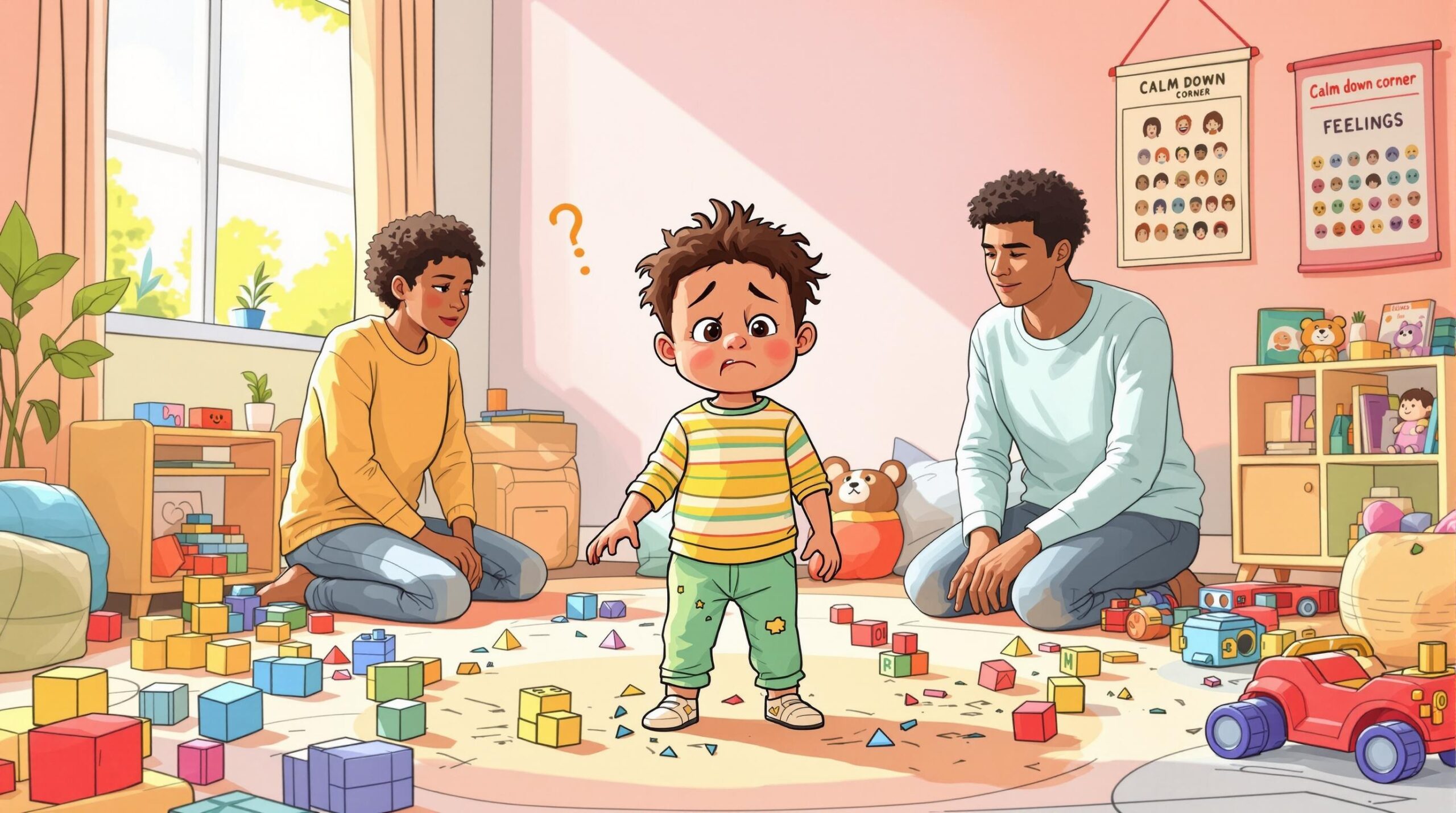Table of Contents
ToggleDealing with aggressive behavior in toddlers can be a challenging aspect of parenting. As a parent, you might find yourself feeling frustrated, overwhelmed, or even embarrassed when your little one lashes out. However, it’s crucial to remember that these behaviors are often a normal part of child development. In this comprehensive guide, I’ll walk you through understanding, managing, and ultimately reducing aggressive behaviors in toddlers.
Understanding Toddler Aggression: A Normal Developmental Phase
Toddler aggression, including hitting, biting, and pushing, is a common occurrence during early childhood. These behaviors typically emerge as toddlers navigate their expanding world with limited verbal skills and emotional regulation capabilities. The American Academy of Pediatrics (AAP) recognizes that toddlers may resort to aggression as a means of communicating their needs or expressing frustrations.
It’s important to understand that toddler aggressive behavior doesn’t necessarily indicate future violent tendencies. Instead, it’s often a temporary phase as children learn to manage their emotions and interact with others. However, addressing these behaviors early on is crucial for teaching appropriate social skills and fostering healthy emotional development.
The Role of Brain Development
During the toddler years, the brain undergoes rapid development, particularly in areas responsible for impulse control and emotional regulation. The prefrontal cortex, which plays a key role in decision-making and behavior control, is still maturing. This developmental stage can lead to difficulty in managing strong emotions, resulting in physical outbursts.
Communication Challenges
Toddlers often have a limited vocabulary and struggle to express complex emotions verbally. When they can’t find the words to communicate their feelings or needs, they might resort to physical actions. For instance, a toddler who wants a toy another child is playing with might hit or push simply because they don’t know how to ask for a turn.

Common Triggers for Aggressive Behavior in Toddlers
Understanding what prompts aggressive behavior is the first step in managing it effectively. Several factors can trigger outbursts in toddlers:
Physical and Emotional States
Tiredness, hunger, and overstimulation are common culprits behind aggressive behavior. When toddlers are exhausted or their blood sugar is low, they’re more likely to act out. Similarly, an environment with too much noise, activity, or sensory input can overwhelm a toddler, leading to aggressive responses.
Frustration and Lack of Control
Toddlers are in a constant state of seeking independence while still relying heavily on adults. This push-pull dynamic can lead to frustration when they can’t do something they want to do or when they’re told “no.” The resulting feelings of powerlessness might manifest as aggression.
Environmental Factors
The NICHD Study of Early Child Care and Youth Development highlights the significant influence of a child’s environment on their behavior. Exposure to aggressive behavior, whether through media, siblings, or adults, can lead toddlers to mimic these actions. Additionally, an unstable home environment or significant changes in routine can increase stress levels, potentially leading to more frequent aggressive outbursts.
Individual Temperament
Each child is unique, and some may be more prone to aggressive behavior due to their innate temperament. Factors such as high sensitivity to stimuli, difficulty with transitions, or a strong-willed nature can contribute to a higher likelihood of aggressive responses.
Effective Strategies for Managing Aggressive Behavior
While it’s normal for toddlers to exhibit aggressive behavior, it’s crucial to address it promptly and consistently. Here are some effective strategies to manage and reduce aggressive outbursts:
Redirection Techniques
When you notice your toddler becoming agitated or on the verge of an aggressive act, quickly redirect their attention to a different activity. This could involve introducing a new toy, suggesting a game, or moving to a different environment. The key is to intervene before the aggressive behavior occurs, breaking the cycle before it starts.
Teaching Empathy and Emotional Expression
Help your toddler understand and name their emotions by providing them with the vocabulary to express their feelings. Use simple phrases like “I see you’re feeling angry” or “It looks like you’re frustrated.” Encourage them to use words instead of actions to communicate their needs and emotions.
Setting Clear Boundaries and Consequences
Establish clear rules about acceptable behavior and consistently enforce them. When setting consequences for aggressive actions, ensure they’re age-appropriate and immediately follow the behavior. For example, if your toddler hits during playtime, a brief time-out or removal from the activity can be effective.
Positive Reinforcement
The Centers for Disease Control and Prevention (CDC) recommends using positive reinforcement to encourage good behavior. Praise your toddler when they handle frustrating situations well or use words instead of physical actions. This positive attention reinforces the behaviors you want to see more often.
The Importance of Consistency and Patience in Behavior Management
Addressing aggressive behavior in toddlers requires a consistent approach and a hefty dose of patience. Here’s why these elements are crucial:
Consistency in Discipline
Toddlers thrive on routine and predictability. When parents consistently respond to aggressive behavior in the same way, it helps toddlers understand the consequences of their actions. This consistency should extend across all caregivers, including parents, grandparents, and daycare providers.
The Power of Patience
Changing behavior takes time, especially for young children who are still developing impulse control. It’s important to maintain realistic expectations and celebrate small improvements. Remember, every child develops at their own pace, and progress may not always be linear.
Avoiding Physical Punishment
The U.S. Department of Health and Human Services strongly advises against using physical punishment to address aggressive behavior. Spanking or other forms of physical discipline can actually increase aggressive tendencies in children, modeling the very behavior you’re trying to discourage.
Fostering Positive Parent-Child Interactions
Parent-child bonding plays a crucial role in shaping a toddler’s behavior and overall development. Here are some ways to foster positive interactions:
Quality Time and Bonding Activities
Engage in activities that promote bonding, such as reading stories together, playing imaginative games, or simply cuddling. These positive interactions help build a strong emotional connection, which can reduce the likelihood of aggressive behavior.
Open Communication
Create an environment where your toddler feels comfortable expressing their feelings. Encourage them to talk about their emotions, both positive and negative. This open dialogue helps them develop emotional intelligence and reduces the need for physical expressions of frustration.
Modeling Appropriate Behavior
Toddlers learn a great deal by observing and imitating their parents. By consistently modeling calm, non-aggressive responses to frustration, you’re teaching your child how to handle difficult emotions appropriately.
Understanding Developmental Milestones and Their Impact on Behavior
Recognizing the developmental milestones your toddler is experiencing can provide valuable insight into their behavior:
Object Permanence and Separation Anxiety
Around 8-12 months, babies develop object permanence – the understanding that objects continue to exist even when they can’t be seen. This milestone can lead to separation anxiety, which might manifest as clingy or aggressive behavior when a parent tries to leave.
Emerging Independence
As toddlers approach their second year, they begin to assert their independence more strongly. This can lead to the infamous “terrible twos,” characterized by tantrums and defiant behavior. Understanding this as a normal phase can help parents respond more patiently.
Language Development
Between 18 months and 3 years, children’s language skills expand rapidly. However, their ability to express themselves often lags behind their understanding, leading to frustration and potentially aggressive behavior when they can’t communicate effectively.
When to Seek Professional Help
While aggressive behavior is common in toddlers, there are instances when professional help might be necessary:
Persistent or Severe Aggression
If aggressive behavior persists despite consistent intervention or is severe enough to cause injury to others, it’s time to consult a pediatrician or child development specialist.
Signs of Underlying Issues
Sometimes, aggressive behavior can be a sign of underlying developmental or emotional issues. If you notice your child struggling with social interactions, having difficulty with change, or showing signs of sensory sensitivities, professional evaluation may be beneficial.
Impact on Daily Life
When aggressive behavior significantly impacts your family’s daily life or your child’s ability to participate in normal activities, seeking professional guidance can provide tailored strategies and support.
Creating a Safe Environment to Reduce Aggressive Behavior
A safe, well-structured environment can significantly reduce triggers for aggressive behavior:
Childproofing and Safety Measures
Ensure your home is free from hazards that might frustrate or endanger your toddler. This includes securing furniture, covering electrical outlets, and removing breakable items from reach.
Establishing a Calm Space
Create a designated “calm down” area in your home where your toddler can go when feeling overwhelmed. Stock this space with soft items, books, and calming activities to help them self-regulate.
Structured Routine
Implement a consistent daily routine to provide a sense of predictability and security. This can include set meal times, nap times, and bedtime rituals, which can help reduce stress and potential triggers for aggressive behavior.
Teaching Empathy and Social Skills to Reduce Aggression
Developing empathy and social skills is crucial in reducing aggressive tendencies:
Role-Playing and Storytelling
Use role-play scenarios or stories to help your toddler understand different perspectives and practice appropriate responses to various situations. This can be particularly effective in teaching alternatives to aggressive behavior.
Encouraging Cooperative Play
Provide opportunities for your toddler to engage in cooperative play with peers. This helps develop crucial social skills like sharing, turn-taking, and conflict resolution in a supervised setting.
Emotional Literacy
Help your toddler build a vocabulary for emotions. Use books, pictures, and everyday situations to discuss different feelings and appropriate ways to express them.
Conclusion: A Comprehensive Approach to Managing Toddler Aggression
Addressing aggressive behavior in toddlers requires a multifaceted approach combining patience, consistency, and positive reinforcement. By understanding the developmental factors at play, identifying triggers, and implementing effective strategies, parents can guide their toddlers towards more appropriate ways of expressing themselves.
Remember, every child is unique, and what works for one may not work for another. Gentle parenting techniques can be particularly effective in managing toddler behavior. Be patient with yourself and your child as you navigate this challenging but temporary phase. With time, consistency, and love, your toddler will develop the skills needed to manage their emotions and interact positively with others.
If you find yourself struggling or if aggressive behavior persists despite your best efforts, don’t hesitate to seek professional help. Early intervention can make a significant difference in your child’s behavioral development and your family’s overall well-being.
Sources:
American Academy of Pediatrics: Effective Discipline to Raise Healthy Children
Centers for Disease Control and Prevention: Developmental Milestones
Centers for Disease Control and Prevention: Positive Parenting
National Institute of Child Health and Human Development: The NICHD Study of Early Child Care and Youth Development
U.S. Department of Health and Human Services: Maternal and Child Health












